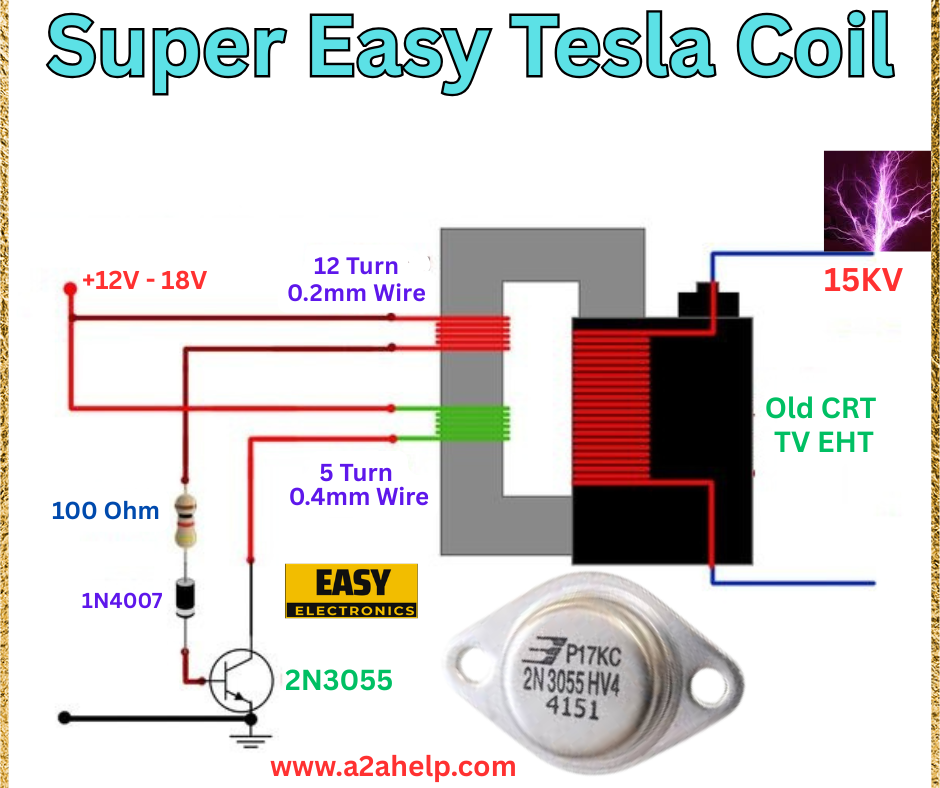Tesla coils are fascinating devices that produce high-voltage, low-current electricity, creating impressive electrical discharges and sparks. If you’re an electronics enthusiast looking to dive into a fun and educational project, the Super Easy Tesla Coil is an excellent starting point. In this article, we’ll explore how to build this simple yet effective Tesla coil using readily available components, its working principle, and safety tips. Perfect for hobbyists in 2025, this guide will help you create your own Tesla coil with confidence!
What is a Tesla Coil?
A Tesla coil is an electrical resonant transformer circuit invented by Nikola Tesla. It generates high-voltage, high-frequency alternating current (AC) electricity. The Super Easy Tesla Coil design, as shown in the image, uses a straightforward setup to produce up to 15kV, making it ideal for educational demonstrations or small-scale experiments.
Key Components of the Super Easy Tesla Coil
- Transistor (2N3055): This NPN power transistor acts as a switch to drive the circuit, handling the high current needed for the coil.
- Diode (1N4007): A rectifier diode that protects the circuit by preventing reverse current flow.
- Resistor (100 Ohm): Limits the current to the transistor, ensuring safe operation.
- Primary and Secondary Coils:
- Primary Coil: 5 turns of 0.4mm wire.
- Secondary Coil: 12 turns of 0.2mm wire.
- Power Supply: +12V to -18V DC input to power the circuit.
- Old CRT TV EHT (Extra High Tension): Provides the high-voltage output of 15kV.
How the Tesla Coil Works
The Super Easy Tesla Coil operates on the principle of electromagnetic resonance. Here’s a simplified explanation:
- Power Input: The circuit is powered by a 12V to 18V DC supply, which energizes the primary coil.
- Oscillation: The 2N3055 transistor oscillates the current through the primary coil, creating a magnetic field.
- Voltage Step-Up: The secondary coil, wound with thinner wire, resonates with the primary coil, stepping up the voltage to 15kV.
- Spark Generation: The high-voltage output from the old CRT TV EHT produces visible electrical discharges.
This resonant transformer design amplifies the voltage efficiently, making it a classic example of Tesla’s innovative work.

Step-by-Step Guide to Building the Tesla Coil
- Gather Components: Collect the 2N3055 transistor, 1N4007 diode, 100 Ohm resistor, and wires (0.2mm and 0.4mm).
- Wind the Coils: Create the primary coil with 5 turns of 0.4mm wire and the secondary coil with 12 turns of 0.2mm wire around a suitable core.
- Assemble the Circuit: Connect the components as shown in the diagram—attach the resistor and diode to the transistor, then link the coils.
- Connect the Power Supply: Use a 12V to 18V DC source, ensuring correct polarity.
- Attach the EHT: Connect the old CRT TV EHT to the secondary coil for high-voltage output.
- Test Safely: Power on the circuit in a controlled environment and observe the sparks.
Applications of the Super Easy Tesla Coil
- Educational Demonstrations: Showcase electromagnetic principles in classrooms or workshops.
- Hobby Projects: Create stunning visual effects for science fairs or personal experiments.
- Wireless Power Experiments: Explore basic wireless energy transfer concepts.
Safety Precautions
Working with high voltage requires care. Follow these tips:
- Use insulated tools and wear rubber gloves.
- Keep the circuit away from flammable materials.
- Test in a well-ventilated, dry area to avoid shocks or short circuits.
Where to Learn More
For detailed schematics and additional resources, check out www.a2ahelp.com. This site offers tutorials and guides to enhance your electronics skills and troubleshoot your Tesla coil project.
Conclusion
Building a Super Easy Tesla Coil is a rewarding project that combines fun with learning. With the right components and careful assembly, you can generate impressive 15kV sparks right at home. Whether you’re a beginner or an experienced engineer, this guide provides everything you need to get started. Visit www.a2ahelp.com for more inspiration and dive into the world of high-voltage electronics today!
